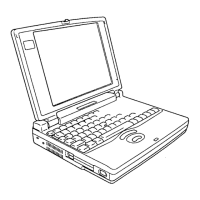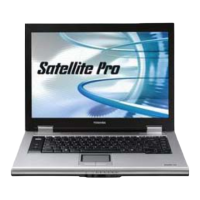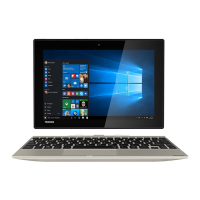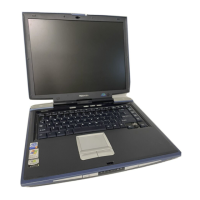
Do you have a question about the Toshiba 100CS and is the answer not in the manual?
Details about the Pentium processor, its clock speed, and voltage.
Specifies standard memory configuration and types.
Describes the internal 528 MB Hard Disk Drive.
Details the 3.5-inch FDD supporting 2HD and 2DD disks.
Information on the 10.4-inch DSTN color LCD and external CRT support.
Description of the 82/84-key keyboard and numeric keypad overlay.
Lists the three types of batteries: main, backup, and RTC.
Details the optional memory module slot for 8, 16, or 32 MB.
Details the 64-bit Pentium processor, math co-processor, and cache.
Specifies 8 MB RAM, 3.3V operation, 70 ns access time.
Describes optional memory modules and maximum capacity.
Provides detailed specifications for FDD modes, capacity, and performance.
Lists specifications for Toshiba and IBM HDD models, capacity, and speed.
Explains the 82/84-key keyboard and pointer control stick.
Details the LCD module, resolution, color capability, and signals.
Specifies the FL inverter board's power and current ratings.
Details the power supply output voltages and regulation tolerances.
Describes the main battery, its function, and the battery icon status.
Explains quick and trickle charge methods and charging conditions.
Lists the main FRUs covered in the troubleshooting section.
Lists the tools required for troubleshooting procedures.
Ensures correct OS, disconnected peripherals, and empty floppy drive.
Checks AC power connection and indicator status.
Checks battery charging status and indicator.
Analyzes error messages displayed during system initialization.
Steps for replacing system board or HDD I/F board.
Instructions for cleaning the floppy disk drive heads.
Running diagnostic tests for the floppy disk drive.
Verifies hard disk partition status using FDISK.
Procedures for low-level and MS-DOS formatting.
Executing the keyboard test program for diagnostics.
Checks keyboard cable connection and replacement.
Checks if the contrast dial affects display brightness.
Running display diagnostic tests.
Steps for replacing display components like FL, inverter, LCD.
Lists functions available in the Diagnostic Test Menu.
Lists necessary equipment for running diagnostic tests.
Steps to insert disk and start the diagnostic program.
Details the main menu options for system, memory, keyboard tests.
Lists subtests for System: ROM checksum, Thermistor check.
Lists subtests for Memory: Constant data, Address pattern, Refresh.
Lists subtests for Keyboard: Pressed key display, PS/2 mouse check.
Lists subtests for Display: VRAM, Character Attributes, Character Set.
Lists subtests for FDD: Sequential read, Sequential read/write.
Lists subtests for Printer: Ripple Pattern, Function.
Lists subtests for HDD: Sequential read, Address uniqueness, Random Address/Data.
Lists subtests for Real Timer: Real time, Backup Memory.
Lists subtests for NDP: NDP test.
Lists subtests for Expansion: PCMCIA wraparound.
Checks ROM checksum from F0000h to FFFFFh (64KB).
Tests conventional memory with constant data write/read.
Tests extended memory in protected mode.
Displays keyboard layout and key presses as '*'.
Displays character attributes: normal, intensified, reverse, blinking.
Displays even, odd, and all dots in 640x200 graphics mode.
Performs Cyclic Redundancy Check (CRC) on all tracks.
Writes and reads data pattern to specified tracks.
Prints characters while shifting left for each new line.
Tests normal print, double width, compressed, and other print types.
Checks data send/receive function via RS-232-C wraparound connector.
Sends data from one machine to another for comparison.
Sequentially reads all tracks on HDD, forward and backward.
Writes/reads unique address data to each sector for comparison.
Performs low-level format of the hard disk.
Performs MS-DOS logical formatting.
Displays system configuration details like BIOS version, memory, drives.
Displays total, base, and extended memory allocations.
Configures display adapter, mode, colors, and power-on display.
Allows setting or resetting the power-on password.
Chart guiding the order of FRU removal for repairs.
Step-by-step instructions for removing the battery pack.
Step-by-step instructions for installing the battery pack.
Instructions for removing an optional PC card.
Instructions for installing an optional PC card.
Instructions for removing an optional memory module.
Instructions for installing an optional memory module.
Step-by-step guide to removing the HDD unit.
Step-by-step guide to installing the HDD unit.
Instructions for removing the keyboard assembly.
Instructions for installing the keyboard assembly.
Instructions for removing the sub-battery and VGA board.
Instructions for installing the sub-battery and VGA board.
Instructions for removing the top cover and display assembly.
Instructions for installing the top cover and display assembly.
Instructions for removing the membrane switch.
Instructions for installing the membrane switch.
Instructions for removing the floppy disk drive.
Instructions for installing the floppy disk drive.
Instructions for removing the AC Power Supply unit.
Instructions for installing the AC Power Supply unit.
Instructions for removing the system board.
Instructions for installing the system board.
Instructions for removing the display mask.
Instructions for installing the display mask.
Instructions for removing the color LCD module.
Instructions for installing the color LCD module.
Precautions to prevent damage when handling the LCD module.
Pin assignments for the PJ1 Thermistor Connector.
Pin assignments for the PJ2 Expansion Memory Connector.
Pin assignments for the PJ5 FDD Connector.
Pin assignments for the PJ7 HDD Connector.
Pin assignments for the PJ15 PC Card Connector.
Pin assignments for the PJ16 VGA Connector.
Lists scan codes for keys in set 1 and set 2.
Shows scan codes when the left Shift key is pressed.
Illustrates the standard US keyboard layout.
Illustrates the German keyboard layout.
Lists the diagnostic disk needed for BIOS rewriting.
Steps to update the system BIOS with a newer version.












